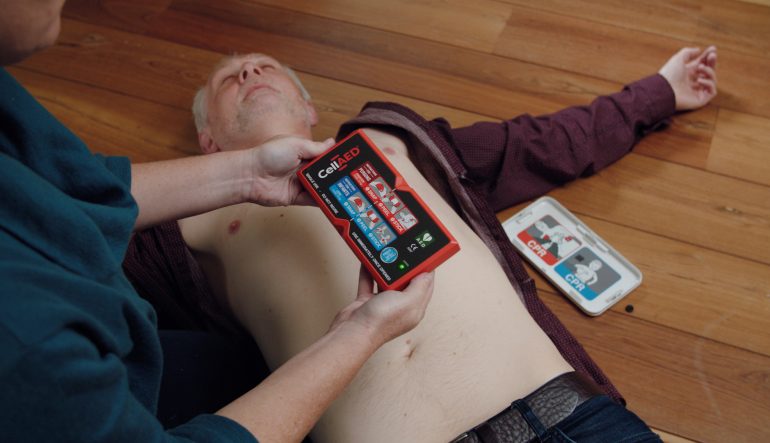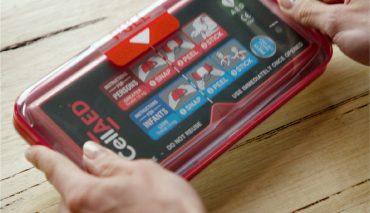The future of defibrillation isn’t science fiction.
Currently-available AED technology hasn’t fundamentally changed in more than 30 years. It’s still expensive, cumbersome, and challenging to use under pressure.
As Dr Melinda Stanners showed us in her excellent history of defibrillation, defibrillators are the only effective treatment for ventricular fibrillation (VF) and ventricular tachycardia (VT).
Yet AEDs (automated external defibrillators) are still difficult to find in an emergency. This is especially true in homes, where as many as 4 out of every 5 out-of-hospital cardiac arrests occur.
We know that better access to AEDs improves out-of-hospital cardiac arrest (OHCA) survival rates. Access means more than just having a device nearby; it’s also about making AEDs easier to use, less expensive, and more reliable.
The future of AEDs
Here’s a scenario of what could be with better technology and supporting systems in-place.
is at home when he suffers a sudden cardiac arrest.
This means he’s dropped to the ground, is unresponsive, and is gasping or moaning – signs of agonal breathing. Michael’s partner, Mary was in a different part of the house – but hears a thump on the floor and comes to investigate.
Mary finds Michael collapsed on the floor. Having done CPR awareness training, Mary knows what to do next: call the emergency number.
As she’s calling, Mary runs to the front hallway where a small, lightweight AED is attached to the wall next to the house security alarm panel. Mary is removing the protective packaging as she returns to Michael.
Under the instruction of the EMS (Emergency Medical Services) operator, Mary has removed Michael’s shirt, performed CPR, and quickly applied the AED pads to his bare chest. This whole process has taken less than a minute.
Mary can do this quickly, because the AED has been designed for rapid deployment. With the pads in place, the AED automatically detects if a shock is required, and gets to work without any manual intervention.
As Michael starts to breathe normally again thanks to the AED’s successful shock delivery, Mary rolls him into the recovery position. EMS is still on the line with Mary, as an ambulance is sent on its way to Michael and Mary’s location.
Connecting the dots
With the AED doing its work, Mary has a few moments to share the AED’s unique ID code with the EMS operator. This allows the EMS operator to access real-time access to a graphical visualisation of the waveform being read by the AED, showing Michael’s heart rhythm before and after any shocks.
This information doesn’t mean anything to Mary, but it’s an open book for the EMS call operator.
This ECG visualisation is shared by the EMS call operator to the paramedics enroute to the scene, via a link accessed on their smartphones. These graphs are giving the paramedics opportunity to assess and diagnose the problem prior to arrival.
By the time they arrive, the paramedics have identified exactly what they need to do next, before they’ve even set eyes on Michael, based on what the smart AED is telling them. This shaves minutes off the time it takes to deliver assistance upon arrival.
After Michael is stabilised following their arrival, the ambulance crew is back on the road, speeding Michael to the nearest trauma centre. The AED pads are still connected to Michael’s chest, and remain so as he is wheeled into Emergency.
One of the first things Michael’s attending clinician does is use a smartphone to scan the AED’s QR code. Seconds later, the smartphone is displaying the same ECG graphs provided to EMS, showing the AED’s pre- and post-shock readings.
With this information literally at their fingertips, Michael’s clinicians are able to more quickly identify the probably likely causes of his cardiac arrest. Decisions on next steps are made, and Michael is whisked away for treatment.
What’s wrong with this picture?
Anyone familiar with the limitations of modern AEDs will be able to separate the fact from fiction of this scenario.
For example, there’s no way the weight and bulk of any AED available for sale today could be neatly fixed to a home hallway wall without causing an obstruction.
It’s also unlikely that those critical first three steps of the Chain of Survival – calling EMS, applying CPR and commencing defibrillation – could happen so quickly. For most modern AED designs, it takes more time just to unbox and assemble them – assuming their batteries are charged, and the perishable pads and gels have been maintained.
It’s hard to believe that in 2021, when our fridges can order milk for us when we’re running low, that AEDs can’t share real-time data to emergency services.
One of the most unbelievable aspects of this scenario however, has nothing to do with connectivity or ease-of-use. It’s that Mary and Michael could afford to have an AED in their home in the first place.
RELATED ARTICLE: Why we invented CellAED®
The future of defibrillation isn’t science fiction
The AED described in this scenario exists, and achieved CE Certification in May.
AEDs need to be affordable for home ownership, and easy to use with minimal training in high-pressure situations. This ease-of-use also requires AEDs to be smaller and more portable, without risk of unattended batteries and perishable components rendering the device unusable through neglect.
CellAED solves these problems.
The capabilities illustrated here are the least of what is possible with advanced AEDs, using technology that exists today.
Michael survived, by the way. He’s in excellent health, thanks in no small part to Mary’s quick actions, the efficient and rapid response of EMS and clinicians, and the capabilities of their not-so-fictional AED.
Scott Casey is and Chief Technology Officer at Rapid Response Revival. Follow Scott here.



